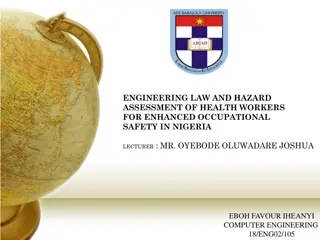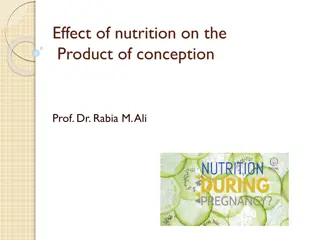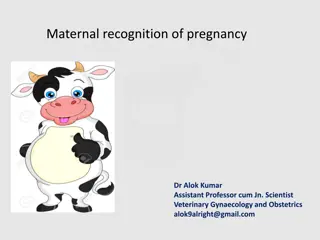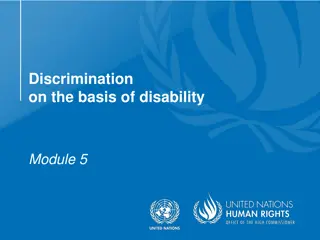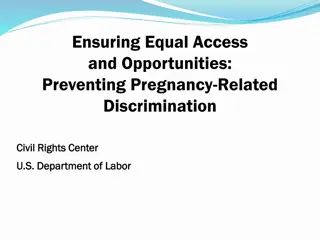Pregnancy Discrimination Issues and EEOC Enforcement
Explore the EEOC's efforts in addressing pregnancy-related limitations under the Americans with Disabilities Act Amendments Act (ADAAA) and the Pregnancy Discrimination Act. Learn about the historical context, the increase in pregnant women in the workforce, and the EEOC's guidance on pregnancy discrimination issues.
Download Presentation

Please find below an Image/Link to download the presentation.
The content on the website is provided AS IS for your information and personal use only. It may not be sold, licensed, or shared on other websites without obtaining consent from the author.If you encounter any issues during the download, it is possible that the publisher has removed the file from their server.
You are allowed to download the files provided on this website for personal or commercial use, subject to the condition that they are used lawfully. All files are the property of their respective owners.
The content on the website is provided AS IS for your information and personal use only. It may not be sold, licensed, or shared on other websites without obtaining consent from the author.
E N D
Presentation Transcript
Peggy Mastroianni Legal Counsel EEOC July 2014 1
Pregnancy Issues and the Strategic Enforcement Plan One of the six national priorities identified in Strategic Enforcement Plan (SEP) is litigating emerging or developing issues One such emerging or developing issue is accommodating pregnancy-related limitations under the Americans with Disabilities Act Amendments Act (ADAAA) and the Pregnancy Discrimination Act (SEP, Part III.B.3) 2
EEOC History on Issues Relating to Pregnancy, Disability, and Caregiver Discrimination Guidelines on Discrimination Because of Sex (1979): http://www.gpo.gov/fdsys/pkg/CFR-2011-title29-vol4/xml/CFR-2011-title29- vol4-part1604.xml Fact Sheet: The Family and Medical Leave Act, the Americans with Disabilities Act, and Title VII of the Civil Rights Act of 1964 (1995): http://www.eeoc.gov/policy/docs/fmlaada.html Enforcement Guidance: Unlawful Disparate Treatment of Workers With Caregiving Responsibilities (2007): http://www.eeoc.gov/policy/docs/caregiving.html Regulations to implement the ADAAA (2011): 29 C.F.R. 1630 Commission Meeting on Unlawful Discrimination Against Pregnant Workers and Workers With Caregiving Responsibilities (2012): http://www.eeoc.gov/eeoc/meetings/2-15-12/index.cfm 3
More Pregnant Women in the Workforce Today, women comprise half of the workforce and increasingly continue to work while pregnant, often through later stages of pregnancy. 1961-65: 44% of first-time mothers worked during pregnancy, and 13% of them stopped work during their first trimester. Compare to 2006-08: 66% of first-time mothers worked during pregnancy, and only 6% of them stopped work during their first trimester. 1961-65: 35% of first-time mothers who worked during pregnancy worked into their final month. Compare to 2006-08: 82% of first-time mothers who worked during pregnancy worked into their final month. 1970: Mean age at first birth was 21.4. Compare to 2007: Mean age at first birth was 25. See National Women s Law Center, Fact Sheet: The Pregnant Workers Fairness Act: Making Room for Pregnancy on the Job (June 2013), available at http://www.nwlc.org/sites/default/files/pdfs/pregnantworkersfairnessfactsheet_w_bill_number.pdf; U.S. Census Bureau, Maternity Leave and Employment Patterns of First-Time Mothers 1961-2008, 4, 6 (Oct. 2011), available at http://www.census.gov/prod/2011pubs/p70-128.pdf. 4
EEOCs Pregnancy Discrimination Guidance Enforcement Guidance: Pregnancy Discrimination And Related Issues http://www.eeoc.gov/laws/guidance/pregnancy_guidance.cfm Questions and Answers about the EEOC's Enforcement Guidance on Pregnancy Discrimination and Related Issues http://www.eeoc.gov/laws/guidance/pregnancy_qa.cfm Fact Sheet for Small Businesses: Pregnancy Discrimination http://www.eeoc.gov/eeoc/publications/pregnancy_factsheet.cfm 5
I. The Pregnancy Discrimination Act (PDA) First clause: The terms because of sex or on the basis of sex include, but are not limited to, because of or on the basis of pregnancy, childbirth, or related medical conditions ; and 42 U.S.C. 2000e (k) (emphasis added). 6
PDA: Adverse Employment Actions Examples: No hire Termination Demotion Failure to promote Failure to transfer Doe v. DOJ, U.S. Marshals Serv., EEOC Appeal No. 0720090006 Harassment Harris v. Soc. Sec. Admin., EEOC Appeal No. 0120121157 7
PDA: Extent of Coverage - Pregnancy, Childbirth, and Related Medical Conditions The PDA gives a woman the right . . . to be financially and legally protected before, during, and after her pregnancy. Leg. History of the PDA Current Pregnancy Past Pregnancy Enforcement Guidance: Unlawful Disparate Treatment of Workers with Caregiving Responsibilities http://www.eeoc.gov/policy/docs/caregiving.html Potential or Intended Pregnancy UAW v. Johnson Controls, 499 U.S. 187 (1991) 8
PDA: Related Medical Conditions Examples of related medical conditions : Complications requiring bed rest Gestational diabetes After-effects of C-section Lactation EEOC v. Houston Funding, 2013 WL 2360114 (5th Cir. 2013) 9
The PDAs Second Clause [W]omen affected by pregnancy, childbirth, or related medical conditions shall be treated the same for all employment-related purposes, including receipt of benefits under fringe benefit programs, as other persons not so affected but similar in their ability or inability to work, and nothing in section 703(h) of this title shall be interpreted to permit otherwise. . . . Examples of such benefits: light duty, leave, health insurance 10
PDA: Light Duty Employer must provide light duty for a pregnant worker if it provides light duty for employees who are not pregnant, but who are similar in their ability or inability to work. Direct evidence of discriminatory denial of light duty to a pregnant worker: Example 9 Supervisor denies pregnant worker s request for light duty, telling her that having a pregnant worker is too much of a liability for the company. 11
PDA: Light Duty, contd Comparator Evidence: Example 10 - Employer Violates PDA by Not Providing Equal Access to Light Duty Employer provides light duty jobs (subject to availability) for any employee who cannot perform a job duty due to injury, illness, or ADA disability. However, employer denies light duty request from pregnant worker with a 20 lb lifting restriction on the ground that pregnancy does not constitute an injury, illness, or disability 12
PDA: Light Duty, contd Comparator Evidence: Example 11 Employer Provides Equal Access to Light Duty Pregnant nursing assistant at long term care facility denied light duty and discharged because she couldn t perform all of her job duties. No PDA violation because employer has only 5 light duty (administrative) jobs which are available to any employee unable to perform a job function. All 5 of these jobs were filled when she made her request. The PDA requires equal access, but not preferential treatment. 13
PDA: Light Duty, contd Proof of Discrimination Through McDonnell Douglas Burden-Shifting Framework: Prima Facie Case pregnant worker shows that a similarly situated non-pregnant worker (e.g., a worker with an on-the- job injury or a worker with a disability) has been given light duty. Legitimate Nondiscriminatory Reason There are a limited number of light duty jobs and they are all filled. Pretext The cap on light duty jobs has been waived in the past for non-pregnant workers. 14
PDA: Leave Pregnancy-Related Medical Leave No forced leave No increased restrictions on pregnancy-related medical leave Parental Leave Must be provided to mothers and fathers on the same terms. 15
PDA: Health Insurance Employers who provide health insurance must include coverage of pregnancy, childbirth, and related medical conditions Health insurance that excludes coverage of prescription contraceptives may violate the PDA http://www.eeoc.gov/policy/docs/decision- contraception.html 16
II. Pregnancy and the Rehabilitation Act EEOC regulations still make a distinction between normal pregnancies and those with complications. See EEOC s Questions and Answers on the Final Rule Implementing the Amended ADA, at Question 23, available at http://www.eeoc.gov/laws/regulations/ada_qa_final_rule.cfm Generally, under the ADAAA/Rehab Act expanded rules of construction and definitions, many more pregnancy-related conditions now may qualify as physical impairments supporting actual disability and record of such disability claims. For example, someone with an impairment resulting in a 20-pound lifting restriction that lasts or is expected to last for several months is substantially limited in the major life activity of lifting. 17
Pregnancy and the Rehab Act: New Rules of Construction Major life activities also include bodily functions, including but not limited to, functions of the cardiovascular, respiratory, circulatory, endocrine, and reproductive and musculoskeletal functions. Substantially limits significantly expanded -- 29 C.F.R. 1630.2(j)(1) (2011) ( An impairment need not prevent, or significantly or severely restrict, the individual from performing a major life activity in order to be considered substantially limiting. ) Exception for transitory conditions no longer applies for actual disability 42 U.S.C. 12102 (2013) 18
Rehab Act: Pregnancy-Related Impairments that May Be Substantially Limiting Examples: Pelvic inflammation may substantially limit walking Pregnancy-related carpal tunnel may substantially limit lifting Disorders of uterus or cervix may substantially limit reproductive function Pregnancy-related sciatica may substantially limit musculoskeletal function Gestational diabetes may substantially limit endocrine function Preeclampsia may substantially limit cardiovascular or circulatory functions 19
Pregnancy-Related Impairments That Are Substantially Limiting Mayorga v. Alorica, Inc., 2012 WL 3043021 (S.D. Fla. July 25, 2012) Plaintiff had a high-risk pregnancy where baby was in breech position throughout, resulting in, inter alia, premature contractions; increased heart rate; severe morning sickness, back pain, and lower abdominal pain; and three emergency room visits. Held: While healthy pregnancies are not covered under ADA, pregnancy-related complications may be disabilities if they are severe or long enough in duration. Motion to dismiss denied and plaintiff directed to file amended complaint alleging specific major life activities which were substantially limited. 20
Common Accommodations for Pregnancy-Related Limitations Modification of job duties, such as provision of light duty or redistribution of marginal functions Modification of work hours Relocation to a different work area More frequent breaks Modification of policies permission to use a stool while on duty or to drink from a water bottle Additional leave 21
Other Avenues to Accommodation Some state laws require some degree of accommodation of pregnancy, including: - Alaska - Illinois - California - Minnesota - New Jersey - Connecticut - Texas - Hawaii - Louisiana Pregnant Workers Fairness Act, S. 942, 113th Cong. (2013), available at http://www.govtrack.us/congress/bills/113/s942 - Maryland - West Virginia 22
Best Practices Protect applicants and employees against retaliation. Make hiring, promotion, and other employment decisions without regard to stereotypes about pregnant workers. Review light duty policies for compliance with the PDA. Ensure that anyone designated to handle reasonable accommodation requests is aware of new rules of construction under the Rehab Act. 23




